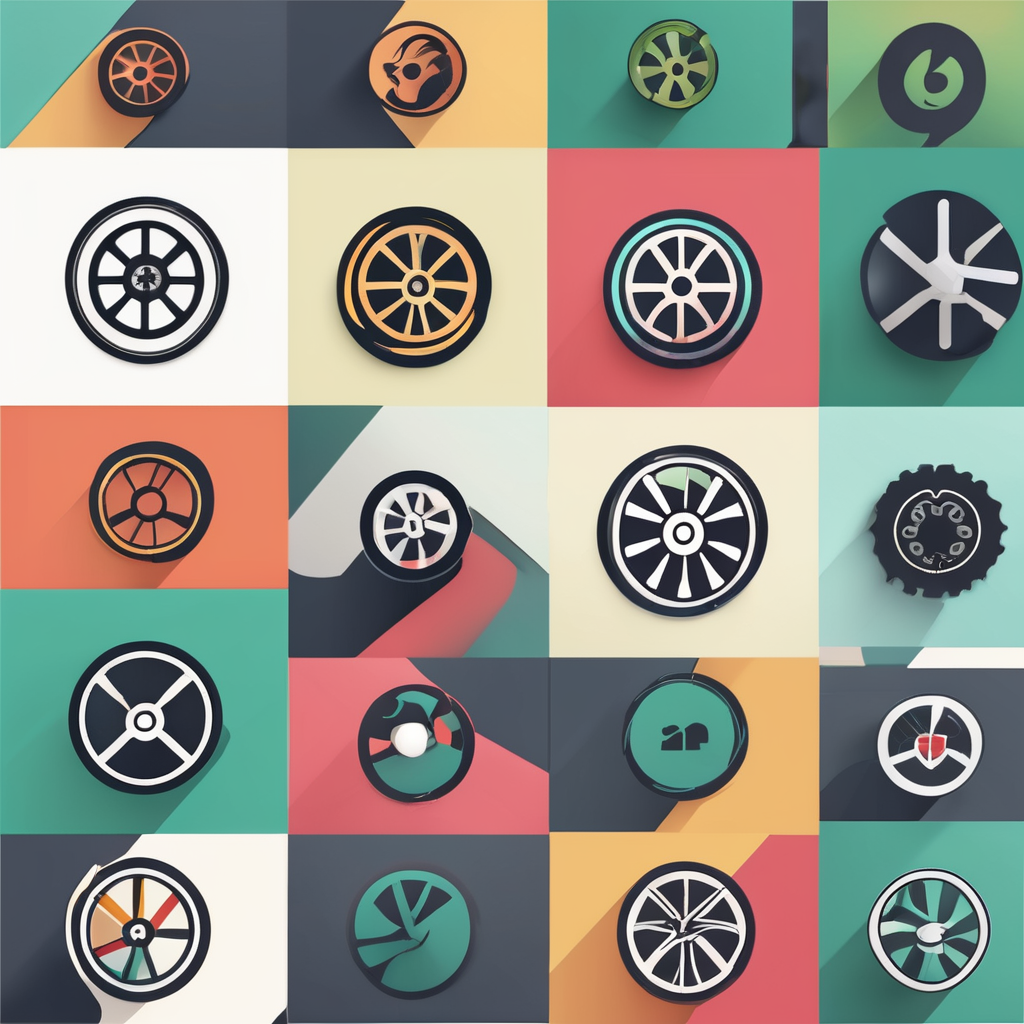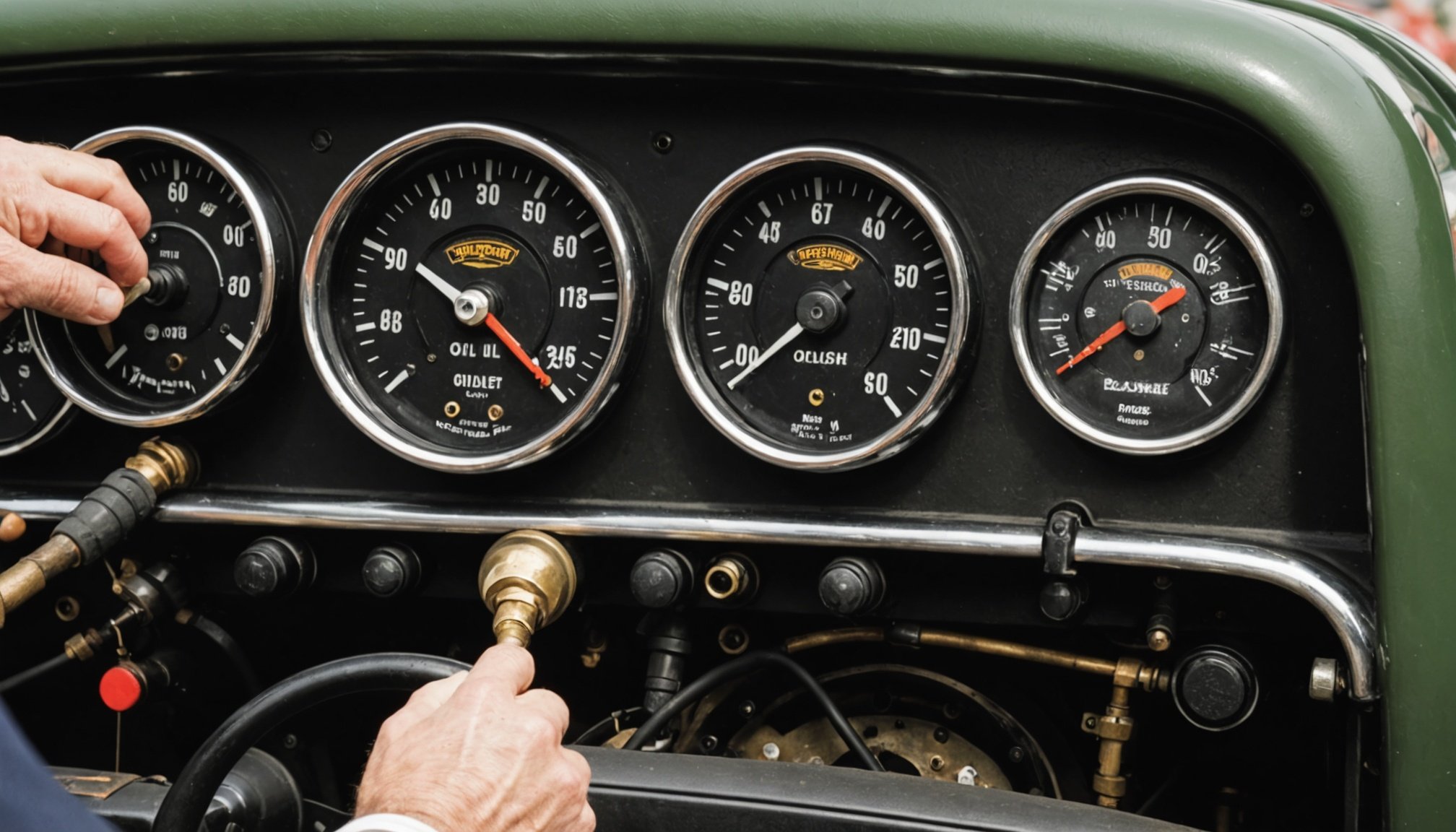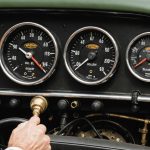Understanding Oil Pressure in British Classic Cars
Oil pressure is a crucial aspect of maintaining the health of British classic cars. At its core, the oil pressure system ensures that engine components are adequately lubricated, helping to avert wear and tear. In classic British vehicles, which often come with unique and delicately balanced oil pressure systems, maintaining optimal pressure is not just recommended—it’s essential.
Proper oil pressure is vital for engine longevity, as it ensures that all moving parts receive the lubrication they need to operate smoothly. If a classic car’s oil pressure falls too low, it might indicate a fault within the oil pump or a leak somewhere in the oil pressure system. Conversely, excessively high oil pressure could suggest blockages or faulty pressure relief valves.
Also read : Why is it important to use UK vehicle glass cleaner specifically designed for automotive use?
Typical oil pressure readings can provide insights into engine health. Generally, when the engine is idling, you should expect lower readings, while higher readings are common at increased RPMs. For instance, many enthusiasts of British classic cars will note that an oil pressure reading of around 40-60 psi at cruising speeds signals a well-functioning engine. Regular monitoring and interpretive understanding of these readings can aid in timely maintenance, helping to prevent significant engine damage and ensuring the timeless charm of British classics graces the roads for years to come.
Measuring Oil Pressure
Understanding oil pressure in your vehicle is vital for ensuring engine health. Accurate measurement is crucial, requiring the right tools and gauge calibration.
Have you seen this : How can I effectively use UK vehicle ceramic coatings for long-lasting protection?
Tools Required for Accurate Measurement
Both mechanical and electronic oil pressure gauges are essential. Mechanical gauges, known for their precision, rely on physical components to show pressure changes, while electronic gauges provide digital readouts, offering ease of use. Adapter fittings and hoses are necessary for a secure connection to the engine, accommodating different vehicle types.
Step-by-Step Measurement Process
Begin by preparing your vehicle. Ensure it’s on a level surface and the engine is off. Next, connect the oil pressure gauge. Attach the adapter fitting to the engine’s pressure port, then secure the gauge using the hoses. Lastly, start the engine and observe the pressure reading. A typical idle pressure ranges between 20-30 psi.
Calibration of Instruments
Gauge calibration is fundamental for reliable results. Regular calibration ensures your gauges reflect true pressure levels. Start by comparing your gauge against a standard known pressure. Adjust according to the discrepancies. Avoid common pitfalls, such as using the wrong calibration standards or neglecting regular checks, which can lead to inaccurate readings and potentially costly vehicle issues.
Adjusting Oil Pressure
Understanding the adjustment of oil pressure is crucial for maintaining optimal engine performance. Several factors can influence the need for oil pressure adjustment, such as engine wear, oil viscosity, and the operational environment of the machine. If the oil pressure is too high or too low, it could signal deeper issues that need addressing.
There are various tools and techniques to help in adjusting oil pressure accurately. A reliable oil pressure gauge is essential, providing a clear reading to guide your adjustments. In some cases, modifying the oil pressure relief valve may be necessary. This valve helps regulate the oil pressure and ensures it remains within specified limits.
Before proceeding with an oil pressure adjustment, you should troubleshoot the current pressure readings. This involves checking for common issues such as faulty sensors, clogs in the oil filter, or degraded oil quality. Your insights can prevent unnecessary adjustments and uncover underlying problems.
Performing an oil pressure adjustment is usually warranted when your readings consistently deviate from the recommended levels. For instance, if you observe fluctuations in oil pressure during normal operations, this may be a clear indicator. Ensuring proper oil pressure is maintained can enhance engine longevity and efficiency.
Diagnosing Oil Pressure Issues
Understanding and diagnosing oil pressure issues is crucial for maintaining your vehicle’s health. These problems can often manifest through a variety of symptoms, and addressing them promptly can prevent more serious damage.
Common Symptoms of Low Oil Pressure
One of the primary signs of oil pressure problems is the illumination of warning lights on your dashboard. This could indicate a significant drop in oil pressure, suggesting an underlying issue. Accompanying this may be unusual engine noise, such as knocking or ticking sounds, which can imply insufficient lubrication. Additionally, if your vehicle exhibits poor performance or inefficient fuel usage, these can also be symptoms of oil pressure problems. It’s essential to also watch for visual indicators, such as oil leaks under the vehicle, which can further tip you off to issues within the system.
Identifying Potential Causes
Low oil pressure can stem from several factors. A failing oil pump is a common culprit as it can no longer maintain adequate oil flow. Blockages in oil lines might also restrict oil movement, while using oil with incorrect viscosity can affect pressure levels.
Diagnosing with Tools and Techniques
To thoroughly troubleshoot oil pressure, using tools like pressure gauges is critical. They can provide accurate readings of current pressure levels. Meanwhile, a visual inspection helps detect any apparent issues like oil leaks, while analyzing oil quality ensures it hasn’t degraded, impacting performance.
Historical Context of Oil Pressure in British Classics
Delving into the history of oil pressure in British classic cars unveils a fascinating evolution of engineering prowess and adaptability. In the early days, oil pressure systems were rudimentary, relying heavily on manual lubrication techniques. However, as the automobile industry advanced, so did the engineering behind these pivotal systems.
British car engineering underwent significant transformations to address oil pressure challenges. Initially, engines were designed with simple oil pumps, which sufficed for low-speed engines. But as performance desires heightened, these systems required innovations. The development of more efficient oil pumps and pressure relief valves became essential to maintain optimal oil pressure, ensuring engine components were lubricated effectively and preventing undue wear.
The journey of oil pressure development didn’t come without its hurdles. Early manufacturers faced historical challenges like oil leaks and inconsistent pressure due to the limitations of materials and technology. Nonetheless, these challenges spurred innovations in oil pressure management, paving the way for more reliable systems.
By understanding these historical developments, one can truly appreciate the ingenuity involved in maintaining the life force of classic British engines. As such, the quest for maintaining balanced oil pressure stands as a testament to the resilience and forward-thinking nature of Britain’s automotive engineering heritage.
Tips for Maintaining Oil Pressure
Maintaining ideal oil pressure is crucial for the longevity and performance of an engine.
Regular Maintenance Practices
Regular checks and maintenance are key to maintaining optimal oil pressure. Ensure scheduled oil changes are performed as they directly influence pressure stability. Old oil becomes contaminated and less effective, leading to pressure drop. Regular inspections can identify issues early, preventing costly repairs. Keep a vigilant eye on oil levels, as both low and excess oil can affect pressure readings and engine health.
Choosing the Right Oil
Selecting the right oil is imperative for proper oil pressure maintenance. Oil viscosity significantly impacts pressure; thicker oils increase pressure, while thinner oils decrease it. For classic cars, using specific oils can help accommodate their unique engine requirements. Synthetic oils, compared to conventional oils, provide better thermal stability and can maintain consistent pressure over varying temperatures.
Tips for Seasonal Adjustments
Seasonal changes require careful adjustments in maintenance routines to manage oil pressure efficiently. For instance, in colder conditions, oil thickens, which can lead to elevated pressure readings. Choosing oils designed for winter can mitigate this issue. Conversely, during the summer, oil may thin, requiring different viscosity to maintain ideal pressure. Preparing your vehicle for extreme weather ensures reliable performance year-round.
Additional Resources and Tools
Understanding oil pressure systems requires the right resources and tools. For those interested in the mechanics behind oil pressure systems, several recommended books and manuals provide in-depth information. Titles like “Engine Oil Fluid Dynamics” offer readers a comprehensive look into oil pressure systems, while manuals from automotive manufacturers serve as essential guides.
Engaging with online forums and communities can also be invaluable, especially for classic car enthusiasts. Forums like ClassicCarTalk and AutomativeForums feature seasoned members who share insights, troubleshoot problems, and provide advice on maintaining and improving oil pressure systems. These platforms foster a community of DIYers and experts, making them excellent places to find practical, real-world solutions.
In addition to reading and engaging online, many find instructional videos and repair techniques especially helpful. Platforms like YouTube host a wealth of content that showcases step-by-step repair processes, which are beneficial for visual learners. Channels dedicated to automotive repair offer tutorials ranging from basic maintenance tips to advanced diagnostic tools analysis, enabling enthusiasts to tackle oil pressure issues with confidence. This multimedia approach ensures thorough understanding and effective troubleshooting, accommodating different learning preferences and skill levels.
Understanding Oil Pressure in British Classic Cars
Oil pressure serves as a critical indicator of engine performance in classic cars. Maintaining an optimal oil pressure is essential for ensuring the engine’s longevity and efficiency. For classic British cars, this involves careful monitoring and comprehension of various readings.
Importance of Oil Pressure for Engine Health
In classic British vehicles, adequate oil pressure prevents friction, reducing wear between engine components. This, in turn, helps maintain the engine in peak performance and extends its life. If oil pressure drops too low, it compromises lubrication and poses a risk of damaging the engine. Conversely, excessively high oil pressure might indicate blockages that need attention.
Common Oil Pressure Readings
Standard oil pressure readings vary, but classic cars generally feature a gauge ranging from 0 to 80 psi. Normal readings during operation are typically between 30 to 55 psi. A reading significantly outside this range could suggest underlying issues, necessitating further inspection.
Factors Influencing Oil Pressure
Several factors can impact oil pressure in classic British cars:
- Oil Viscosity: Using incorrect oil thickness can alter pressure levels.
- Engine Temperature: Extreme temperatures may affect pressure consistency.
- Engine Wear: Older engines might exhibit different pressure characteristics.
Understanding these factors helps enthusiasts manage oil pressure effectively, safeguarding their vehicle’s cherished heart.
Tools for Measuring Oil Pressure
When it comes to measuring oil pressure in classic cars, having the right oil pressure gauge is crucial. These diagnostic tools can be found in two main types: mechanical and electrical. Mechanical gauges, considered more traditional, utilise a long tube filled with oil or mercury, which physically moves a needle on a dial to reflect the engine’s oil pressure. On the other hand, electrical gauges rely on a sensor and a wire connection to provide digital readings.
Installation of an oil pressure gauge typically involves mounting the gauge on the dashboard and connecting it to a T-piece from the engine’s oil supply line. Once installed, it is important to know how to accurately read the gauge. Watching for the needle’s movement or studying the digital readout can give crucial insights into the engine’s health.
Calibration of these measurement tools ensures that they deliver precise readings, reducing the risk of misdiagnoses. Calibration often requires comparison against a standard pressure reading. Regular calibration checks can maintain the effectiveness and extend the lifespan of your diagnostic equipment. Ensuring these tools are properly installed and calibrated is essential for maintaining classic car engines’ functionality and reliability.
Step-by-Step Guide to Adjusting Oil Pressure
Adjusting oil pressure is essential in classic car maintenance, and tuning it right ensures your vehicle performs optimally. Here’s a guide to help you adjust oil pressure successfully.
Preparing for Adjustment
Before diving into the oil pressure adjustment, take essential precautions. Ensure your car engine is cool to prevent burns. Gather necessary tools, including a pressure gauge, wrench, and safety gloves. Locate the pressure relief valve in your engine to facilitate tuning.
Adjusting the Pressure Relief Valve
Once prepared, proceed to adjust the pressure relief valve. This valve controls the flow of oil and dictates pressure levels. First, locate the valve on your engine. Use a wrench to loosen the locking nut carefully, allowing you to adjust the screw. Turn the screw clockwise to increase pressure or counterclockwise to decrease it. Each turn should be small to avoid excessive adjustments. Tighten the locking nut back after achieving the desired settings.
Testing and Verifying Adjustments
Upon completing the adjustment, it’s crucial to test your changes. Start your engine and monitor the oil pressure gauge to verify adjustments. Retesting ensures the pressure is within the recommended range and the engine is safe. If the pressure is off, repeat the tuning process until satisfactory. Regular monitoring helps maintain optimal performance.
Common Oil Pressure Issues in British Classic Cars
Oil pressure problems are prevalent in many British classic cars. Recognising the symptoms early is crucial. Frequent indicators include an illuminated oil pressure warning light and unusual noises coming from the engine. Classic car enthusiasts may notice the oil gauge showing lower-than-usual readings. Such tell-tale signs warrant immediate attention to prevent further damage.
Troubleshooting techniques are essential when diagnosing oil pressure problems. Begin by checking the oil levels; low oil levels could lead to reduced pressure. Examining the oil filter is also crucial, as a clogged filter can restrict flow, impacting pressure. It is beneficial to inspect the oil pressure sending unit and the pressure relief valve for any faults.
When addressing oil pressure problems, several recommended solutions exist. Firstly, ensure that the engine oil is of the correct specification for the car model. Using the wrong viscosity can lead to inadequate pressure. Replacing a worn-out oil pump might be necessary if all other components function correctly. Additionally, checking the engine bearings for wear and tear can help, as worn bearings can reduce pressure.
Regular maintenance and careful troubleshooting can alleviate many oil pressure issues, ensuring the longevity and performance of cherished classic vehicles.
Maintenance Tips for Sustaining Optimal Oil Pressure
Ensuring optimal oil pressure is crucial for maintaining the health of any vehicle, especially when engaging in regular oil maintenance. Implementing effective engine care practices can significantly extend the life of your vehicle. Regular oil changes, as prescribed by your vehicle’s manual, help preserve the engine’s components and avoid unnecessary damage.
For owners of classic cars, particularly British models, using the right type of oil is vital. Heritage engines often require specifically formulated oils that cater to their unique needs. Adhering to the manufacturer’s recommendations, or consulting a specialist in classic car upkeep, helps maintain proper function and oil maintenance efficiency.
Staying attuned to signs of trouble ensures timely intervention. Indicators such as a flickering oil pressure warning light, unusual engine noises, or persistent low oil pressure readings should not be overlooked. These symptoms often suggest the need for a professional inspection to assess potential issues.
Engage with these engine care tips to confidently navigate oil maintenance challenges. By combining regular scrutiny with informed choices, you can secure the longevity and dependable performance of your vehicle.
Case Studies and Real-World Examples
Classic car enthusiasts have a treasure trove of stories about oil pressure experiences, which often highlight the intricacies involved in maintaining these vintage vehicles. One memorable anecdote features an owner who discovered drastically low oil pressure while on a countryside drive. This experience led to immediate action, preventing potential catastrophic engine damage. Moreover, it underscored the significance of regularly monitoring oil gauges.
Mechanics, with years of expertise, have shared valuable insights into the importance of maintaining optimal oil pressure. They emphasise that consistent oil pressure ensures proper lubrication and cooling of the engine’s components. This, in turn, prolongs the lifespan of the vehicle and enhances its performance. Regular checks and using high-quality oil are some of the proactive steps mechanics advocate to maintain sufficient pressure.
Several case studies exemplify successful oil pressure adjustments. For instance, a classic car restoration workshop achieved a notable increase in oil pressure by upgrading to a more efficient oil pump and replacing worn-out gaskets. This not only improved engine performance but also instilled confidence in the vehicle’s long-term reliability. Such instances serve as a testament to the practical benefits derived from careful oil pressure management in classic cars.
Diagrammatic Representation of Oil Pressure Systems
Understanding oil pressure diagrams is vital for those keen on maintaining British classic cars. These diagrams serve as classic car schematics, offering a blueprint for navigating the oil pressure system.
When examining an oil pressure diagram, one should start by identifying the main components: the oil pump, pressure valve, channels, and gauges. These elements are fundamental in regulating and measuring the oil pressure.
Key Components
-
Oil Pump: This component powers the circulation of oil, ensuring efficient lubrication and cooling. Locating it in the diagram allows for a better grasp of its interaction with other parts.
-
Pressure Valve: This part helps maintain optimal pressure levels. By recognising its schematic representation, enthusiasts can anticipate areas requiring adjustment or maintenance.
-
Channels and Gauges: Channels route the oil through the system, and gauges measure the pressure levels. These are essential in diagnosing potential issues within the system.
Visual Aids for Clarity
Using visual aids alongside these diagrams enhances understanding. They break down complex details into digestible steps, making the adjustment and measurement methods more approachable. For classic car enthusiasts, mastering the reading of these diagrams is an empowering step toward preserving vehicle performance and longevity.











